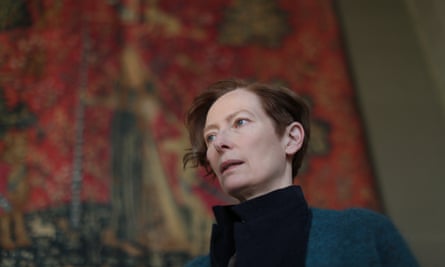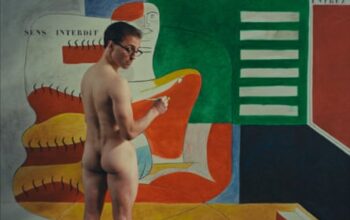T
As the days get shorter, the ground becomes frosty and you can see your breath in the cold air. This time of year calls for a chilling tale that will catch you off guard. According to renowned director Martin Scorsese, Joanna Hogg is at the perfect point in her career to direct such a film. Hogg recalls, “He was trying to encourage me to collaborate on a ghost story with him. He believed it could be a new direction for me, so I asked him to recommend some ghost stories for me to read.” As promised, Scorsese suggested some titles, including Rudyard Kipling’s “They,” “Casting the Runes,” and “The Mezzotint” by MR James, as well as works by Robert Aickman and Edith Wharton.
Hogg’s latest film, The Eternal Daughter, is a powerful and moving work. With Martin Scorsese as executive producer and Tilda Swinton as the lead actress, the film takes place in a quiet, isolated hotel where a fragile older mother and her middle-aged daughter have taken a short trip to celebrate a birthday. The hotel itself is a classic, eerie structure with creaky floorboards and unexplainable chills. It’s the type of place where you can’t help but feel like you might encounter a ghost or two…
However, the initial supernatural tone introduced by Scorsese is only a small aspect of the film’s origin. As a filmmaker, Hogg emerged later compared to her peers, having gained experience as a director in mainstream TV drama. Her debut film Unrelated, released in 2007 when she was in her late 40s, surprised and impressed critics. It was a well-crafted first feature that avoided the common pitfalls of first-time filmmaking. The film portrayed a childless woman in her forties on vacation with friends who have children, showcasing confidence, wit, and effective storytelling (as well as launching a breakout role for a young Tom Hiddleston).
After completing her previous project, Unrelated, Hogg had planned to create The Eternal Daughter, a film centered around her relationship with her mother. However, she ended up producing two more independent films, both of which were well-received and also featured Hiddleston. The first, Archipelago (2010), explored the dynamics of a troubled family reuniting on the Isles of Scilly. The second, Exhibition (2013), was a dramatic portrayal of a relationship featuring Viv Albertine, the guitarist from the Slits. Hogg then went on to create a stunning and ambitious coming-of-age story set in the 1980s, told in two parts: The Souvenir (2019) and The Souvenir: Part II (2021). These films were inspired by Hogg’s personal experiences while attending film school.
In both of the Souvenir movies, she collaborated with Swinton. They have been close friends since they were children and previously worked together on Hogg’s first short film, Caprice (1986). Swinton describes their long-standing relationship as “the original working partnership,” explaining that it greatly influenced her and allowed for personal and emotionally raw exploration of difficult topics. Looking back, she realizes that many of their shared interests and conversations in their youth revolved around experiencing life from a similar perspective of detachment and alienation. She now sees this as a filmmaker’s ongoing dialogue.
Martin Scorsese, who first encountered Hogg’s work by watching Archipelago on DVD, became the executive producer for both Souvenir films and The Eternal Daughter. He has described her films as having “implosions” instead of the explosive characters he typically focuses on. Hogg’s style of filmmaking involves carefully observed characters, long and stationary shots, naturalistic lighting, and writing that delves into the psychological depth and perception of a novelist like George Eliot. Her stories often follow seemingly low-key plots, similar to the style of Japanese director Yasujirō Ozu.
While her films are very British in some ways – setting, characters, emotional restraint – her work has shone on the world stage, where critics and audiences seem more at ease with her nuanced and realistic portrayals of upper middle-class material comfort paired with emotional anxiety. Her films have played abroad at prestigious international film festivals, while bizarrely being snubbed by Bafta back home. Perhaps that is to do with Oscar Wilde’s theory about the rage of Caliban on seeing himself reflected in the looking glass.
Why did it take Hogg a long time to bring The Eternal Daughter back to life? Hogg’s speaking style is cautious but direct; it leaves you with the impression of someone who always strives to be completely truthful and precise, even about topics that may be difficult to discuss. In Hogg’s words, “Similar to Julie in the eventual movie, I was sidetracked by concerns about upsetting my mother. There were feelings of remorse – all of those emotions that are present in the film and that I examine in a nuanced way within the film. So I set it aside.”
None of this is to suggest that Hogg’s bond with her own mother, who died in 2021, was not a positive one; more that she felt an intense sense of responsibility around any portrait she might attempt to create. “We had a very good relationship, and I was very, very fond of her,” she says. “So I felt the responsibility as a daughter of wanting her to be as happy as possible, and in that process I would lose a sense of myself. It would take me a while to gather myself up after visiting her.”
Many children, regardless of their gender, can understand the feeling of wanting to take care of someone without them knowing. According to Hogg, this sense of responsibility as a daughter can develop at a young age, depending on the dynamic and circumstances of the relationship. Personally, Hogg felt this responsibility and concern for her mother at a young age, which may not have been entirely healthy.
After over ten years of creating the idea, Hogg was prepared to produce the movie: “By then, I believed that I could potentially discover a method to create it without feeling like I am following in my mother’s path.”
During these periods of forced creative brainstorming, unexpected and fruitful changes can occur. Despite the original gothic fiction aspect, the most significant change to the initial idea was suggested by the film’s lead actress. What if, in addition to portraying the daughter Julie, Tilda Swinton also took on the role of the mother? This idea was casually brought up one day during a conversation and had not been previously considered.

Most actors would not take this suggestion seriously, especially since Hogg’s film-making process is not conventional. Instead of writing a script, Hogg creates a 30-page document outlining the general plot of the film. Her actors do not have specific lines to memorize, but rather understand their character’s role in the scene. Swinton explains that this method allows for a natural and balanced performance, without the added stress of technicalities like remembering lines and coordinating with others. The dialogue in Hogg’s films comes from within the actors themselves.
However, considering this method, how was it feasible for Swinton to portray two characters at once?
“Tilda is impressively improvising with herself,” exclaims Hogg. “She’s so talented, and I’m still amazed by what she accomplished.” Before filming, Hogg would join Swinton on set and play one of the characters in the scene, using it as a starting point for their conversation. After trying it once, Hogg would step away and Swinton would continue the conversation as if speaking to thin air. Once Hogg felt they had captured enough material, there would be a change in costume, hair, and makeup, and the other half of the scene would be filmed with Swinton playing the other character.
Ignore the newsletter advertisement.
after newsletter promotion
Hogg states that Tilda’s performance was exceptional. She was able to bring out the subtle differences between her characters, including their gestures, which added an element of possession.
The issue of ownership and trust is heavily present here, especially considering the concerns that led Hogg to delay the project. It brings to mind the famous quote by Oscar Wilde: “All women become like their mothers. That is their tragedy. No man does. That’s his.” The film illustrates the concept of our parents being a reflection of our future selves, to the point where it’s challenging for the audience to imagine the film without the central theme of duality.
Hogg explains that our mothers are a reflection of ourselves in various aspects. Therefore, it is logical to merge the two. As someone who has always been fascinated by ghost stories, turning it into one was a way for me to distance myself from my own mother and view it as something separate. Additionally, I have always been intrigued by the concept that our mothers become future ghosts in a sense. This fear has existed within me since childhood, the thought of my mother no longer being present.
Hogg’s The Eternal Daughter shares many themes with her 1980s Souvenir films, which also featured Swinton as a character named Rosalind based on Hogg’s mother. In The Eternal Daughter, the elderly Rosalind is approximately the same age as Hogg’s mother would have been during the filming of the Souvenir films. In both sets of films, Rosalind’s daughter is played by Swinton’s real-life daughter Honor Swinton Byrne, and is named Julie. Swinton even wears the same dresses in important birthday party scenes in both films, blurring the lines between identities. However, Swinton clarifies that “Julie is not either of us, and Rosalind is not our mothers. They are familiar figures, but still leave room for wonder.” Therefore, it is better to view the characters as a poetic reflection rather than a form of ventriloquism.
Hogg won’t be drawn too much on what might be next for her as a film-maker, but she does talk with cautious enthusiasm about a possible change of gear, or shift into new territory: “I feel that I’ve just got the engine going with something new. I want to try new things. I’m turning in a slightly different direction. I feel on a personal level the need to keep being adventurous, and my idea of adventure is being creative and making films. And there’s only a finite amount of time.”
It is tempting to ask what Hogg’s mother finally thought of The Eternal Daughter in the end, after all that time. It’s a question sadly destined to an eternity without an answer. “In fact, my mother died when we were editing,” Hogg says. “She was very much looking forward to seeing the film, so I’m very sad that she never saw it.” Her tone is composed, but she then repeats herself a little, as if she can’t quite believe it. “I was worried about her seeing it, but she died when we were editing … ”
She pauses and says, “I then realized that I was able to manage both my creative work and the loss of my mother simultaneously. However, I didn’t fully experience the grief until almost a year after her passing. I’m not sure if creative work can truly replace the process of grieving when you lose someone.”
“The task is the task.” She stops once more and repeats, “The task is the task.”
The Eternal Daughter is in UK and Ireland cinemas from Friday. The seasons, Internal Reflections: The Films of Joanna Hogg and Joanna Hogg: Influences, run at BFI Southbank during November.
Source: theguardian.com


